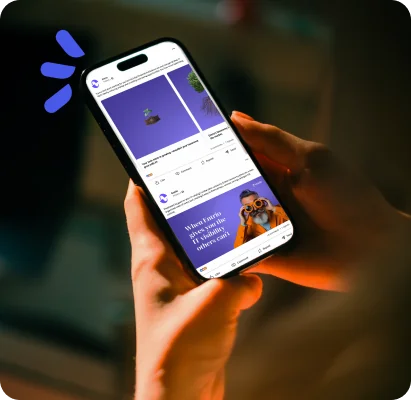
This blog was originally published in 2023 and has been updated in 2025 to reflect how we’re using AI in copywriting today. At Accelity, we’re always testing new tools to help us work smarter and better serve our clients.
When you think of using AI for marketing, content is probably the first thing that comes to mind. If students are writing essays with it, marketers must be using it too… right?
Yes and no. AI tools like ChatGPT can crank out a blog post in seconds, complete with keywords and a passable attempt at brand voice—but let’s be real, it still sounds like a robot. So while it’s not replacing your marketing team anytime soon, it is helping us write stronger, faster, and more creatively.
We asked our Strategic Copy Manager, Michelle Breen (hi, it’s me 👋), to share which tools are actually worth your time and where human creativity still reigns supreme. Here’s what she had to say about AI in content marketing. ⬇️
Tools our copy team is testing
We don’t just talk about AI—we experiment with it regularly. These are the tools we’ve been hands-on with lately, along with some quick takes on when and how we use them.
ChatGPT
ChatGPT is still the most well-known AI writing tool. It’s flexible, fast, and—with the right prompt—can do everything from outlining a blog to planning your next vacation.
The paid version has been well worth the spend. I’ve been able to customize my chats to understand exactly how I prefer to write and what style I’m going for. Accelity’s recent rebrand was a breeze because I was able to upload our new brand guide, which included writing conventions, style and tone, and train ChatGPT to write in our brand voice.
Google Gemini
Gemini is Google’s answer to ChatGPT: a generative artificial intelligence chatbot. Gemini is included with our Google Workspace membership, and it's embedded within Google Docs. So while I write this, I can highlight a section of copy that I’m struggling with and ask for help rephrasing, shortening, elaborating or changing the tone. It’s not quite as robust as ChatGPT, but if the tool is already included in your Workspace, it’s great to test.
GrammarlyGO
For years, Grammarly has been helping us tighten copy and triple-check for typos. The addition of generative AI features inside Grammarly Pro goes beyond grammar to rewrite, shorten, and shift tone based on your goals.
Perplexity
We haven’t used Perplexity as much yet, but it’s supposed to be the next big thing, even bigger than Google. We’ll see if that claim sticks. It’s on our list to try next!
If you’re curious about whether Perplexity or ChatGPT is the right tool for you, there are tons of comparison articles on the subject.
4 ways AI makes content marketing easier
AI can’t replace a great writer—but it’s a useful tool for getting started, moving faster, and exploring new angles.
1. Get unstuck with outlines
Staring at a blank screen is the worst. AI can create a solid content outline in seconds, giving you a running start and structure to build on.
Prompt: Write a high-level outline of a blog about writing a website that converts.
- Start with strategy: Know your audience and goals
- Nail your messaging hierarchy
- Write clear, compelling headlines
- Focus on benefits, not just features
- Use calls-to-action that inspire action
- Keep the copy scannable and easy to digest
- Build trust with social proof
- Optimize for search without sounding robotic
- Test, tweak, repeat: copywriting is never one-and-done
2. Say it differently (again and again)
Campaign messaging is often repetitive by design, but that doesn’t mean the copy has to be. AI helps shake up your phrasing without changing the message. This is especially helpful when testing variations for email and paid ads!
| Original copy | Updated copy applying brand voice |
| We create marketing strategies to help businesses grow. | Variation 1 – Bold + confident: We build marketing strategies that fuel fast, measurable growth. Variation 2 – Clear + benefit-driven: We turn your big goals into smart marketing plans that drive results. Variation 3 – Friendly + straightforward: We help you figure out what works—and then build a marketing strategy around it. |
3. Tailor copy to different brand voices
Your marketing doesn’t have to be boring. With a little tweaking, AI can help adapt content for different tones and styles. Just keep in mind it still struggles with humor and nuance—your client’s voice will always need a human touch.
| Original copy | Updated copy applying brand voice |
| Marketing is essential for business growth. It helps companies reach new customers, increase brand awareness, and drive revenue. A strong marketing strategy involves identifying target audiences, choosing the right channels, and measuring success through key performance indicators. | Marketing isn’t just a checkbox—it’s how companies grow smarter and faster. With the right strategy, you can connect with the people who matter, build a brand that actually resonates, and track real results along the way. Bold goals? Marketing gets you there. |
4. Brainstorm headlines, subject lines and microcopy
It’s easier to write 1,000 words than six perfect ones. AI tools are great for brainstorming short-form copy that grabs attention and includes the right keywords.
Prompt: Write 5 headlines for a blog about using generative AI in copywriting
- How to use generative AI to write smarter, not lazier
- The copywriter’s guide to working with—not against—AI
- Generative AI won’t replace copywriters—but it will change the job
- Exploring the role of generative AI in copywriting
- Blending human creativity with AI: A modern approach to content creation
How NOT to use AI in copywriting
Let’s be clear: AI is a tool, not a replacement.
If you’re thinking about overhauling your content process, keep these limitations in mind:
AI isn’t always up to date.
It can’t give you the latest on breaking news, industry trends, or even changes from the last few months. If you’re writing time-sensitive content, human research is non-negotiable.
It won’t generate unique ideas.
AI pulls from what’s already out there. It might help spark a new perspective, but it won’t create something truly original. That’s your job.
It lacks human nuance.
Marketing that resonates? It’s emotional. Sarcastic. Empathetic. Brand-savvy. AI can get you started, but people write the words that truly connect.
Where AI fits in your content strategy
Generative AI has come a long way, and it’s only getting better. While it won’t be taking over your copy team anytime soon, it’s already making our work sharper, faster, and more flexible. The key is knowing when to use it—and when to trust your gut instead.
Curious how we blend smart tools with human creativity to build bold, effective marketing? Let’s talk.
^ChatGPT wrote that. It’s pretty good! When I originally wrote this blog in 2023, the conclusion was way too long, spent too much time regurgitating what I said, and didn’t have the main takeaway I would’ve wanted to share.
For more on using AI in your marketing strategy, check out Superpower Your Marketing Strategy with AI and Friend or Foe? Generative AI for Graphic Design.
Subscribe to our newsletter
Curated content, news articles, team updates and more.



